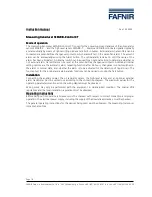
21
Operation
0.01N KCI: f (T) = c
1
T
5
+ c
2
T
4
+ c
3
T
3
+ c
4
T
2
+ c
5
T + c
6,
where:
c
1
= 1.4326 x 10
–9
, c
2
= –6.0716 x 10
–8
, c
3
= –1.0665 x 10
–5
, c
5
= –5.3091 x 10
–2
, c
6
= 1.8199.
•
Salt
is based on the manufacturer’s saltwater compensation.
f (T) = c
1
T
7
+ c
2
T
6
+ c
3
T
5
+ c
4
T
4
+ c
5
T
3
+ c
6
T
2
+ c
7
T + c
8
where:
c1=1.2813 x 10
–11
, c
2
= –2.2129 x 10
–9
, c
3
= 1.4771 x 10
–7
, c
4
= –4.6475 x 10
–6
,
c
5
= 5.6170 x 10
–5
, c
6
= 8.7699 x 10
–4
, c
7
=–6.1736 x 10
–2
, c
8
=1.9524.
•
StdMth
will remove any temperature compensation, so the readings are
equivalent to conductivity: f(T)=1.
•
Custom
will provide a compensation function that the user can define according
to the following function:
f (T)= aT
7
+ bT
6
+ cT
5
+ dT
4
+ eT
3
+ fT
2
+ gT + h.
•
Select the Set Range (1:Auto, 2:High, 3:Mid, or 4:Low).
•
Auto
(default) allows the multiprobe to automatically select the most appropriate
range to measure conductivity. The multiprobe will dynamically change the range
based on the current measurement conditions over 0–100 mS/cm. The resolution
of the displayed data will also change to accommodate the current range in use.
•
High
,
Mid
, and
Low
force the multiprobe to measure conductivity using a fixed
range. If low range is selected, the readings will indicate an over-ranged condition
for values above 1.5 mS/cm. The Mid range will over-range at 15 mS/cm. These
choices also force the displayed readings to a fixed point or constant resolution
format primarily only needed for certain SDI-12 data loggers. Otherwise, it is best
to always select the Auto choice as this gives the best accuracy and performance
for the conductivity sensor.
•
Select the computation method for salinity (1:2311 or 2:StdMth).
•
2311
(default): salinity is computed using an algorithm adapted from the United
States Geological Survey Water-Supply Paper 2311 titled “Specific Conductance:
Theoretical Considerations and Application to Analytical Quality Control”. This
salinity function is only defined from salinities in the 30 to 40 ppt range (mild
concentrations and dilutions of sea water). This salinity function uses specific
conductance values C in mS/cm compensated.
Salinity = c
1
C
4
+ c
2
C
3
+ c
3
C
2
+ c
4
C + c
5
where:
c
1
= 5.9950 x 10
–8
, c
2
= –2.3120 x 10
–5
, c
3
= 3.4346 x 10
–3
, c
4
= 5.3532 x 10
–1
,
c
5
= –1.5494 x 10
–2
.
•
StdMth
: salinity will be computed using the Practical Salinity Scale (1978). This
algorithm is defined for salinities ranging from 2 to 42 ppt and uses conductivity
values corrected to 15 °C, regardless of the compensation function selected for
specific conductance. This algorithm is described in section 2520B of “Standard
Methods for the Examination of Water and Wastewater”, 18th edition.
Summary of Contents for Hydrolab DS5
Page 2: ......
Page 8: ......
Page 14: ......
Page 17: ...17 Installation Figure 5 Assembly Options...
Page 18: ......
Page 34: ...34 Deployment Figure 12 Open Water Deployment...
Page 52: ......
Page 68: ......
















































